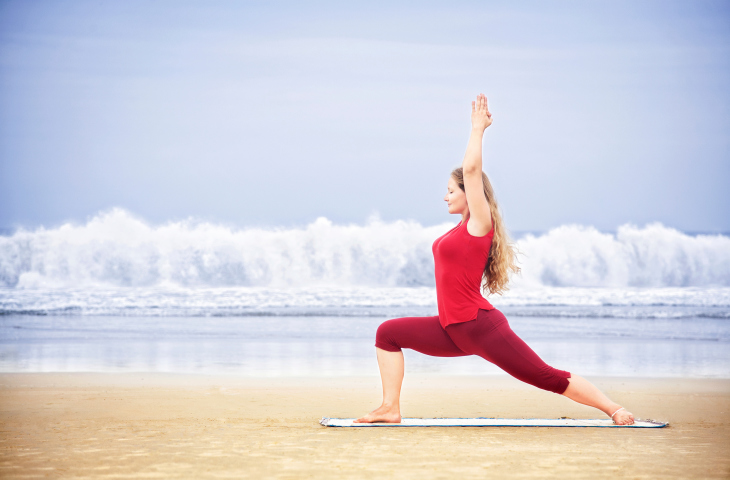
by guest blogger Holly Walck, devoted Iyengar yoga student and teacher
“I just went to for my annual checkup and I was a half-inch taller than last year, before I started to practice yoga!”
Yoga teachers near and far often hear this exclamation by surprised students. It speaks of one of those moments when, as a student, you are filled with the blissful wonder of possibility, much like children who see fireflies for the first time and realize they can actually catch light.
It is true that one of the many wonderful gifts that a skillful yoga practice can offer us is improved posture, and when we stand up straighter, we are taller. However, did you know that improving your posture might also help your digestive system function more effectively, decrease stress on the discs in your lower spine, and boost your mood?
Standing up straight calls for our muscles to be both long and strong, and this requires a methodical approach to yoga practice. The following sequence is designed to lengthen muscles that, when contracted, pull us out of alignment, and strengthen muscles that, when weakened, contribute to the downward pull of gravity (and aging!). May it illuminate your way to a healthy, long-term relationship with your body, mind, and heart.
EnJOY!
Begin in Mountain Pose (Tadasana)
Upward Arm Stretch Pose (Urdhva Hastasana)
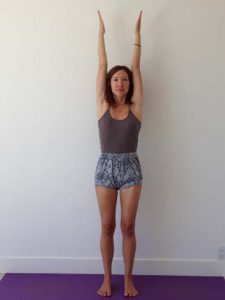 • From Tadasana, while maintaining the actions in your upper arms, shoulders, or shoulder blades, raise your arms out in front of you and up overhead. If your arms begin to bend, straighten them fully by pressing your outer elbows in and stretching up from the inner upper arms to the inner elbows and inner wrists, and all the way through the fingertips.
• From Tadasana, while maintaining the actions in your upper arms, shoulders, or shoulder blades, raise your arms out in front of you and up overhead. If your arms begin to bend, straighten them fully by pressing your outer elbows in and stretching up from the inner upper arms to the inner elbows and inner wrists, and all the way through the fingertips.
• Observe how raising your arms overhead has lengthened the sides of your trunk. Without losing any of that length, while exhaling, lower the arms back to Tadasana. Repeat 3 to 5 times.
Upward, Interlaced Fingers Pose (Urdhva Baddhanguliyasana)
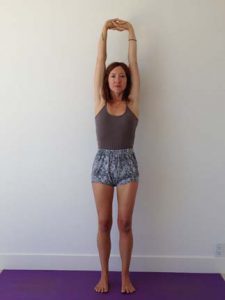 • From Tadasana, while maintaining the actions in your upper arms, shoulders, or shoulder blades, raise your arms out in front of you halfway.
• From Tadasana, while maintaining the actions in your upper arms, shoulders, or shoulder blades, raise your arms out in front of you halfway.
• Interlace the fingers tightly, turn the palms away from you, straighten the arms, and then raise them up overhead. If your arms begin to bend, straighten them fully by pressing your outer elbows in and stretching up from your inner upper arms all the way to your inner wrists.
• Observe the effect that raising the arms up overhead with the fingers interlaced has on the spine. Keep the spinal muscles moving in toward the spine and, while exhaling, lower the arms back to Tadasana. Repeat 3 to 5 times.
Mountain Pose (variation)
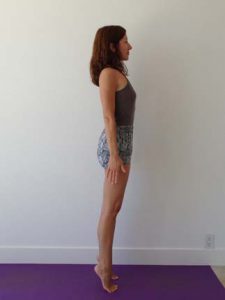 • From Tadasana, slowly raise your heels off the floor. Keep the weight of the body balanced evenly between the balls of your big toes and your little toes.
• From Tadasana, slowly raise your heels off the floor. Keep the weight of the body balanced evenly between the balls of your big toes and your little toes.
• Raise your heels as high as you can off the floor while continuing to lengthen the bottoms of your toes forward. Balance for 10 to 20 seconds and then slowly and evenly lower both heels down to the floor. Repeat 3 times.
Note: If you find it difficult to balance, practice this variation facing a wall, resting your fingertips on it, and try taking your fingertips off the wall once you have raised your heels up off the floor.
Warrior I (Virabhardrasana I)
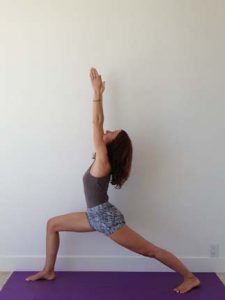 • From Tadasana, step your feet 4 to 4½ feet apart, keeping your feet facing forward, take your hands back behind you and interlace your fingers as you did in Upward, Interlaced Fingers Pose (if you find it difficult to interlace your fingers without bending your elbows, then place your hands on your waist). Maintain all of the shoulder, upper arm, and shoulder blade actions from Tadasana.
• From Tadasana, step your feet 4 to 4½ feet apart, keeping your feet facing forward, take your hands back behind you and interlace your fingers as you did in Upward, Interlaced Fingers Pose (if you find it difficult to interlace your fingers without bending your elbows, then place your hands on your waist). Maintain all of the shoulder, upper arm, and shoulder blade actions from Tadasana.
• Turn your entire right leg out and your left foot almost all the way in, taking care to see that the center of your right thigh, knee, shin, ankle, and the top of your foot are facing the wall in front of you. The left side of your pelvis and your trunk will want to turn back to the left. While exhaling, pull your right outer hip back toward the wall behind you and move your left buttock, waist, and back ribs away from the right so that both sides of your torso face the wall in front of you.
• On an exhalation, while continuing to lengthen the sides of your trunk as you did in Upward Arm Stretch Pose, and maintaining the spinal action from Upward, Interlaced Fingers Pose, bend your right knee, moving your right buttock bone down until it’s in line with the back of your knee.
• Maintain the full extension of your back leg and release the interlacing of your hands. Bring your arms into the classic position while stretching them out from the center of your chest. Raise your head and look up.
• To come out of the pose, lower your head, keep your right knee facing forward, press down on your left heel, and straighten your right leg, then lower your arms as in Tadasana. Turn your legs, pelvis, abdomen, and chest back to face forward. Repeat on the other side.
Warrior II (Virabhadrasana II)
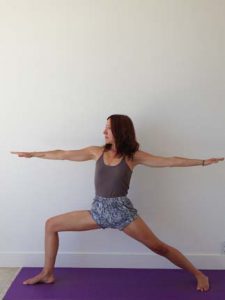 • From Tadasana, step your feet 4 to 4½ feet apart, keeping your feet facing forward, take your hands back behind you and interlace your fingers as you did in Upward, Interlaced Fingers Pose (if you find it difficult to interlace your fingers without bending your elbows, place your hands on your waist). Repeat all of the shoulder, upper arm, and shoulder blade actions from Tadasana.
• From Tadasana, step your feet 4 to 4½ feet apart, keeping your feet facing forward, take your hands back behind you and interlace your fingers as you did in Upward, Interlaced Fingers Pose (if you find it difficult to interlace your fingers without bending your elbows, place your hands on your waist). Repeat all of the shoulder, upper arm, and shoulder blade actions from Tadasana.
• Turn the left foot slightly in and the entire right leg out, taking care to see that the center of your right thigh, your right knee, shin, and ankle, and the top of your right foot are facing the wall on your right side.
• Keep the trunk of your body in Tadasana and, on an exhalation, while continuing to lengthen the sides of your trunk as in Upward Arm Stretch Pose and the spinal action from Upward, Interlaced Fingers Pose, bend your right knee. Keeping your pubic bone level from right to left, move your right buttock bone down until it’s in line with the back of your knee.
• Maintain the full extension of your back leg and release the interlacing of your fingers. Bring your arms into the classic position while stretching them out from the center of your chest.
• To come out of the pose, keep your right knee facing forward and press down on your left heel as you straighten your right leg. Turn your right leg back to face forward then repeat on the other side.
Sage Twist Pose (Bharadvajasana I)
 • Sit on a block with your legs stretched straight out in front of you and, on an exhalation, swing your legs to the left, placing your feet outside your left hip so that the inner right arch is a bed for the top of the left foot. Keep your knees as close together as possible and see that the right knee lines up with the right hip.
• Sit on a block with your legs stretched straight out in front of you and, on an exhalation, swing your legs to the left, placing your feet outside your left hip so that the inner right arch is a bed for the top of the left foot. Keep your knees as close together as possible and see that the right knee lines up with the right hip.
• Keeping the outer left shin, the ankle, and the little toe down on the floor, with your next exhalation, swing your right arm around behind you and clasp your left bicep. Revolve your trunk to the right, turning the right side of the abdomen, chest, ears, and temples more and more to the right.
• Exhale and come back to the center, releasing the twist from the temples, ears, chest, and finally, the abdomen.
Note: People with knee issues can sit higher up on more support or sit on chair.
If you have a shoulder issue, don’t swing your arm around behind you. Rather, go slowly and use the belt, practicing so that you don’t feel any pain in your shoulder.
Upward Extended Legs Pose (Urdhva Prasarita Padasana)
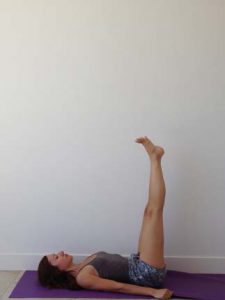 • Lie down on your back with your knees bent. Observe that as you bring both legs up simultaneously into your chest, the sides of your waist descend down towards the floor and your lower spine lengthens.
• Lie down on your back with your knees bent. Observe that as you bring both legs up simultaneously into your chest, the sides of your waist descend down towards the floor and your lower spine lengthens.
• Without losing any of the length in your lower spine, keep the sides of your waist descending down toward the floor and raise your legs until they are perpendicular to the floor (if your hamstrings are tight and your knees bend or your legs are straight but can’t come to perpendicular, try placing a folded blanket under your pelvis).
• Keep your legs in this position for 10 to 15 seconds and then lower them, reversing the path they traveled when you went into the pose. Repeat 5 times, building up to 10 repetitions.
Four-Footed Pose (Chatush Padasana)
 • Lie on your back and bend your knees into your chest. Clasp your ankles and try to maintain the clasp while lowering your feet back to the floor. Exhale and, while pressing your feet and the tops of your shoulders down into the floor, raise the backs of your thighs, buttocks, and waist and the back of your ribcage up off the floor.
• Lie on your back and bend your knees into your chest. Clasp your ankles and try to maintain the clasp while lowering your feet back to the floor. Exhale and, while pressing your feet and the tops of your shoulders down into the floor, raise the backs of your thighs, buttocks, and waist and the back of your ribcage up off the floor.
• Pull the top of your shins back toward your chest to come more onto the tops of your shoulders and repeat all the arm actions from Tadasana: Roll the tops of the shoulders back, turn the triceps down toward the floor and the biceps toward the ceiling, and move the outer shoulder blades in.
Note: Use a belt around your ankles if your hands don’t stay clasped when your feet are on the floor.
Corpse Pose (Savasana)
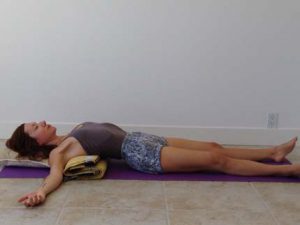 • Place a tri-folded blanket under the bottom half of your shoulder blades and, with your arms stretching out to the side, support your head on a blanket.
• Place a tri-folded blanket under the bottom half of your shoulder blades and, with your arms stretching out to the side, support your head on a blanket.
• Keeping your arms and legs lengthening and releasing away from your trunk, close your eyes and open your ears to the sound of your breath. Slowly over the next few breaths, move your inhalations farther up into the space inside your chest. Pause slightly at the top of the inhalation and allow the fullness of the lungs to gently stretch the intercostal muscles between the ribs. While exhaling, maintain the expansion of that inner space and let your nerves begin to flow as freely as your breath.
• After a few minutes, return to normal breathing and allow yourself to rest sweetly in that calm, luminous inner space that is your Truth.
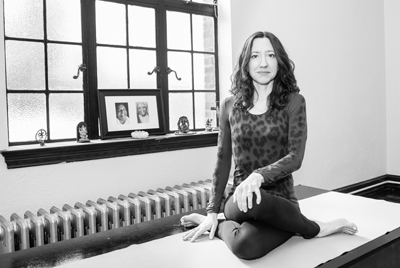 Holly Walck is a devoted student and teacher of Iyengar Yoga. She teaches public classes at the BKS Iyengar Yoga Institute of Los Angeles. Read more about Holly at www.iyengaryogamalibu.com.
Holly Walck is a devoted student and teacher of Iyengar Yoga. She teaches public classes at the BKS Iyengar Yoga Institute of Los Angeles. Read more about Holly at www.iyengaryogamalibu.com.

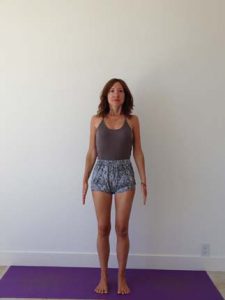
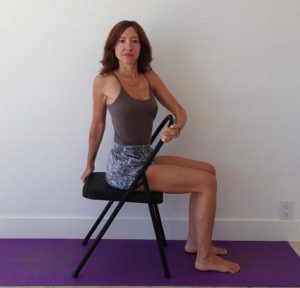
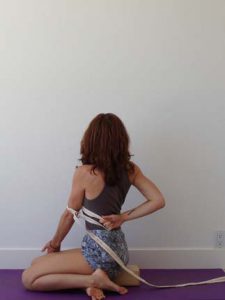
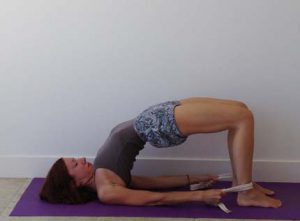



i think these are some very good exercise ‘s i will have to try them